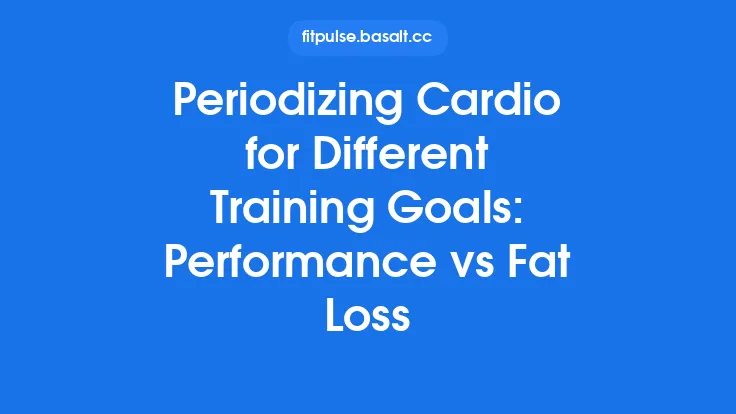Cycling performance doesn’t improve by simply logging more kilometers; it improves when training is organized in a purposeful, progressive structure that balances stress and recovery. Periodized training plans provide that structure, allowing cyclists of any ability to develop aerobic capacity, muscular endurance, and race‑day sharpness while minimizing the risk of stagnation or overreaching. Below is a comprehensive guide to building, customizing, and executing periodized training programs that remain relevant year after year.
Understanding Periodization: The Core Principles
Periodization is the systematic division of the training year into distinct phases, each with a specific physiological focus. The underlying principles are:
- Specificity – Training stress should mirror the demands of the target events.
- Progressive Overload – Gradual increases in volume, intensity, or complexity stimulate adaptation.
- Recovery Integration – Planned reductions in load allow the body to consolidate gains.
- Individualization – Plans must reflect the athlete’s current fitness, goals, and life constraints.
When these principles are applied consistently, cyclists experience measurable improvements in power output, endurance, and efficiency without the erratic peaks and valleys that characterize ad‑hoc training.
The Building Blocks: Macrocycles, Mesocycles, and Microcycles
A periodized plan is organized hierarchically:
| Level | Typical Duration | Primary Focus |
|---|---|---|
| Macrocycle | 12–24 weeks (or an entire season) | Overall objective (e.g., “prepare for a spring criterium series”) |
| Mesocycle | 3–6 weeks | Specific adaptation stimulus (e.g., “high‑intensity threshold block”) |
| Microcycle | 1 week | Detailed day‑to‑day workouts and recovery days |
The macrocycle sets the long‑term goal, mesocycles break that goal into manageable chunks, and microcycles translate each chunk into concrete sessions. By nesting these cycles, coaches can manipulate training variables (volume, intensity, frequency) with precision.
Choosing a Periodization Model for Cycling
Several models exist, each with strengths that suit different rider profiles and competition calendars.
Linear Periodization
Structure: Volume starts high and gradually declines while intensity rises in a predictable, stepwise fashion.
Best For: Riders with a single, well‑defined target race and a relatively straightforward calendar.
Undulating (or Daily‑Undulating) Periodization
Structure: Intensity and volume fluctuate from day to day or week to week, preventing monotony and offering frequent high‑intensity stimuli.
Best For: Cyclists who need to maintain a broad fitness base while still sharpening race‑specific power, such as those competing in a series of varied events.
Block Periodization
Structure: Concentrated “blocks” of high‑intensity work (e.g., 2–3 weeks of VO₂max focus) are sandwiched between lower‑intensity recovery periods.
Best For: Advanced athletes targeting specific physiological adaptations (e.g., lactate threshold elevation) within a limited time window.
Selecting a model hinges on the rider’s experience level, competition density, and personal response to training stress.
Tailoring Periodization to Different Skill Levels
Beginners
Goal: Build a robust aerobic foundation while learning to manage training load.
Approach:
- Macrocycle: 16‑week plan emphasizing steady‑state endurance (60–70 % of max heart rate) for the first two mesocycles.
- Mesocycles: Introduce short, low‑volume intervals (e.g., 4 × 2 min at moderate intensity) in the third mesocycle.
- Microcycles: Keep weekly volume moderate (4–6 h) with at least two full rest days.
Intermediate
Goal: Refine threshold and VO₂max capabilities while preserving endurance.
Approach:
- Macrocycle: 20‑week plan with a clear “build” phase (higher intensity) followed by a “peak” phase (taper).
- Mesocycles: Alternate between endurance (2–3 weeks) and threshold/VO₂max blocks (1–2 weeks).
- Microcycles: Incorporate 2–3 high‑intensity sessions per week, balanced by longer aerobic rides.
Advanced / Elite
Goal: Optimize all energy systems, fine‑tune race‑specific power, and peak at multiple key events.
Approach:
- Macrocycle: 24‑week plan split into multiple mini‑peaks aligned with a race calendar.
- Mesocycles: Use block periodization to target specific adaptations (e.g., a 3‑week VO₂max block, a 2‑week lactate threshold block).
- Microcycles: Include 4–5 high‑intensity sessions, strategic “recovery weeks,” and regular performance testing to adjust training stress.
Integrating Key Training Elements Within a Periodized Framework
While the overall structure dictates when stress is applied, the content of each session determines what stress is applied. A balanced cycling plan typically cycles through the following intensity zones:
| Zone | Approx. % of Functional Threshold Power (FTP) | Typical Session Goal |
|---|---|---|
| Endurance | 55–75 % | Aerobic base, fat oxidation, long rides |
| Tempo | 76–90 % | Sustainable effort, improves muscular endurance |
| Threshold | 91–105 % | Increases lactate clearance, raises sustainable power |
| VO₂max | 106–120 % | Boosts maximal oxygen uptake, short high‑intensity intervals |
| Sprint/Neuromuscular | >120 % | Enhances peak power and recruitment speed |
A periodized plan staggers these zones across mesocycles. For example, a “threshold mesocycle” may consist of 2–3 threshold rides per week, supplemented by a single endurance ride and a recovery day. Conversely, a “VO₂max block” would feature 2–3 high‑intensity intervals (e.g., 5 × 4 min at 110 % FTP) with lower‑volume endurance rides to maintain aerobic capacity.
Recovery Weeks and Deloads
Every 3–4 weeks, a reduced‑load microcycle (often called a “recovery week”) should be inserted. Volume drops by 20–30 % and intensity is kept at the lower end of the endurance zone. This systematic reduction prevents chronic fatigue and facilitates super‑compensation.
Monitoring Progress and Adjusting the Plan
A periodized plan is a living document; it must evolve based on objective feedback.
- Performance Testing – Conduct a standardized test (e.g., 20‑minute FTP trial) at the start of each mesocycle. The resulting data guide adjustments to target zones.
- Training Load Metrics – Track weekly Training Stress Score (TSS) or an equivalent load index. A gradual upward trend (≈5–10 % per mesocycle) signals appropriate overload, while sudden spikes warn of potential overreaching.
- Intensity Distribution – Review the proportion of time spent in each zone. If threshold time is consistently low, consider adding a dedicated threshold session.
- Adaptive Adjustments – If an athlete reports persistent fatigue, reduce volume by 10–15 % for the next microcycle and reassess. Conversely, if performance plateaus despite adequate recovery, a modest increase in high‑intensity volume may be warranted.
Regular data reviews (weekly or bi‑weekly) keep the plan aligned with the athlete’s evolving physiology.
Seasonal Planning: Aligning Training with Competition Calendars
Even though the article avoids deep “endurance ride planning,” it is still essential to position the macrocycle relative to key events.
- Off‑Season (General Preparation) – Focus on low‑intensity volume, skill work (e.g., pedal technique), and addressing any lingering imbalances.
- Pre‑Season (Specific Preparation) – Transition to higher‑intensity work, introduce race‑pace intervals, and begin sharpening efforts.
- Competition Phase (Peak & Taper) – Reduce overall volume while maintaining or slightly increasing intensity to preserve fitness. The final 7–10 days before a target race constitute the taper, where training load drops dramatically to allow full physiological recovery.
Multiple peaks can be accommodated by nesting shorter “mini‑peaks” within the broader macrocycle, each followed by a brief recovery block.
Common Pitfalls and How to Avoid Them
| Pitfall | Why It Happens | Prevention |
|---|---|---|
| Over‑emphasis on a single zone | Desire to chase a specific metric (e.g., threshold power) | Ensure each mesocycle includes a balanced mix of zones; use a periodization template that mandates at least two zones per week. |
| Neglecting recovery weeks | Misconception that “more is always better” | Schedule deload weeks in the calendar and treat them as non‑negotiable. |
| Rigid adherence to the plan despite fatigue | Lack of real‑time monitoring | Incorporate weekly load checks; be prepared to shift a high‑intensity session to an easier day if TSS spikes. |
| Inconsistent testing | Forgetting to re‑baseline fitness | Set calendar reminders for FTP or other benchmark tests at the start of each mesocycle. |
| Trying to fit too many races | Over‑ambitious race calendar | Prioritize key events; use secondary races as “training rides” rather than performance goals. |
By recognizing these traps early, cyclists can keep their training trajectory on an upward slope.
Practical Tips for Implementing a Periodized Plan
- Use a Planning Spreadsheet or Dedicated Software – Populate columns for date, zone, duration, and target intensity. Color‑code macro‑, meso‑, and micro‑cycles for quick visual reference.
- Set Weekly “Focus” Statements – e.g., “Week 5: Threshold endurance – 2 threshold rides, 1 long endurance ride.” This keeps the plan purposeful.
- Batch Create Sessions – Draft workout templates (e.g., “4 × 5 min @ 95 % FTP, 5 min recovery”) and copy them into the calendar as needed.
- Maintain a Simple Log – Record perceived exertion, heart rate, and any notable fatigue. Even a brief note each day provides valuable context for later adjustments.
- Communicate with Coaches or Training Partners – Sharing the periodization outline invites external accountability and fresh perspective on load management.
Bringing It All Together
Periodized training transforms the chaotic accumulation of miles into a strategic roadmap that guides cyclists from novice to elite performance. By understanding the hierarchy of cycles, selecting a model that matches personal goals, customizing the plan for skill level, and continuously monitoring load and response, athletes can achieve steady, sustainable gains while avoiding the common setbacks of overtraining and stagnation. The evergreen nature of periodization lies in its adaptability: as race calendars shift, technology evolves, or personal circumstances change, the same principles can be re‑applied, ensuring that every cyclist—whether chasing a first century ride or a world‑class podium—has a clear, evidence‑based pathway to peak performance.





